|
|
||
|
INTRODUCTION
Today’s parents are concerned about aesthetics for their children. Aesthetic dentistry can provide the beautiful smile that both parents and children desire. Self-image is very important for our young patients so they can look and feel good about themselves. We have all experienced the wonderful smile a patient gives to us when we have turned the “ugly duckling into a beautiful swan.” We are so fortunate to have the dental materials and devices that allow us the opportunity to provide the very best in aesthetic dentistry.
Some of the techniques and materials we have available for our teenage patients’ smile creations include: porcelain veneers, direct composite veneers, microabrasion, bleaching, orthodontics: including clear braces and aligners, direct and indirect composite restorations, implants, and porcelain crowns. The purpose of this article is to provide a brief synopsis and to illustrate various aesthetic restorative options that can be used for our child and adolescent patients. Also, some of the latest innovations in dental restorative techniques will be briefly described and illustrated. The author’s intent is to broaden the scope of aesthetic dentistry for children and teens.
Primary Anterior and Posterior Teeth
Anterior primary teeth can be restored with various tooth-colored restorations. Unfortunately, we have many children who suffer from early childhood caries. Fortunately, we do have aesthetic alternatives. With the development of aesthetic restorations, there is no reason for a child to go to school with the silver stainless steel crowns on his/her anterior teeth. We have wonderful aesthetic crowns as alternatives including: celluloid strip crowns, open face stainless steel crowns, stainless steel crowns with white facings, and acrylic or polycarbonate crowns. A child who has one or more missing anterior primary teeth can have an aesthetic maintainer replacing missing teeth fabricated.
Permanent Anterior Teeth
There are several alternatives for aesthetically restoring permanent teeth in children and teenagers. Let’s take a look at several common aesthetic problems that we find in young patients and the aesthetic alternatives that are available today. Enamel hypocalcification and hypoplasia are a common aesthetic concern. When these conditions occur on the facial surfaces of anterior teeth, direct composite veneers are an option to improve the aesthetics of the smile. Figures 1a to 1d illustrate the use of direct-bonded composite resin to mask the enamel hypocalcification/ enamel hypoplasia on the facial surface of a permanent central incisor. Microabrasion can also be utilized in some situations to reduce the white and/or brown hypocalcified areas in the enamel (Figures 2a and 2b) (Opalustre [Ultradent Products] and Prema [Premier Dental]). In the case of anterior teeth that are imperfect in shape and/or size, composite or porcelain veneers can also be utilized (Figures 3a to 4b). Class III carious lesions can also be restored aesthetically (Figures 5a and 5b).
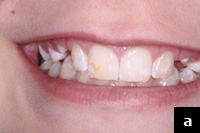 |
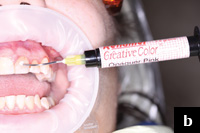 |
|---|---|
|
Figure 1a. Enamel hypocalcification. |
Figure 1b. Opaquer placed over discolorations due to hypocalcification (Creative Color [Cosmedent]). |
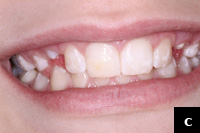 |
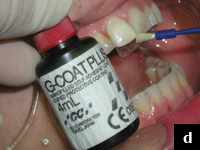 |
|
Figure 1c. Completed composite resin restoration (Vitalescence [Ultradent Products]). |
Figure 1d. Resin Coating placed over composite veneer (G-Coat Plus [GC America]). |
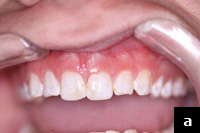 |
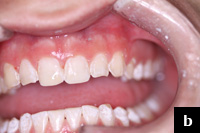 |
|
Figures 2a and 2b. Enamel hypocalcification before and after microabrasion Opalustre [Ultradent Products] and Prema [Premier Dental]). |
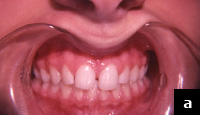 |
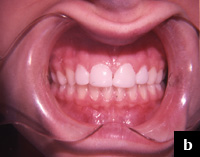 |
|
Figure 3a and 3b. Correction of anterior diastema with direct-bonded composite veneers. |
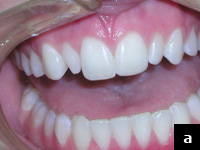 |
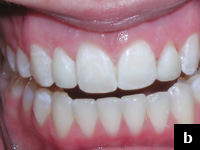 |
|
Figur |
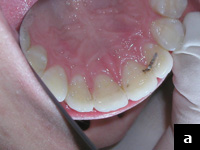 |
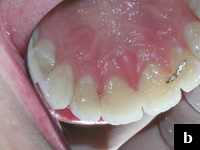 |
| Figures 5a and 5b. Class III caries in permanent maxillary incisors; preparations were done with the Erbium laser (Waterlase MD [Biolase Technology]). Final restorations (Venus Diamond Composite [Heraeus Kulzer]). |
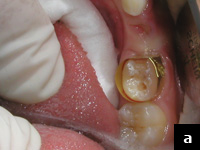 |
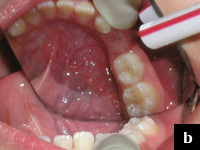 |
| Figures 6a and 6b. Primary tooth with Class II caries and restoration with a flowable composite layer followed by regular bodied composite (Venus Diamond Composite). |
Primary Posterior Teeth
Fortunately, there are many choices available in the cosmetic restoration of primary posterior teeth. Figures 6a and 6b illustrate the aesthetic technique that may be used for restoring carious primary molars.
Permanent Posterior Teeth
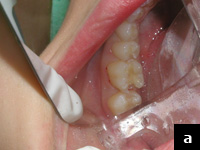 |
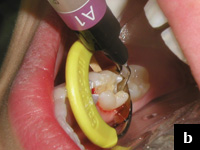 |
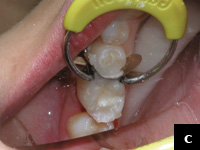 |
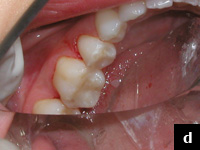 |
| Figures 7a to 7d. Permanent tooth with Class II caries. Two-step primer and bonding agent (Clearfil SE Protect [Kuraray]); flowable composite and composite restoration. (Majesty [Kuraray]). Note use of segmental matrices (Garrison Dental Solutions). |
Class I, II, and V caries can also be restored as aesthetic restorations. In Figures 7a to 7d, 2 Class II restorations are shown.
Fractured Anterior Teeth
Fractures of primary and permanent anterior teeth can be restored with composite materials (Figures 8a to 8d). Porcelain veneers may also be used for permanent anterior teeth.
NEW INNOVATIONS
There have been several innovations that have made the preparation and restoration of primary and permanent teeth more efficient and practical for the dentist, and more comfortable for the patient. Among the most significant innovations is in the area of adhesive dentistry. The dental manufacturers have continually improved the materials for self-etching prior to the placement of the restorative material of choice. There are now primers which are antibacterial and bonding agents that contain fluoride. These additions will help us eliminate the need for cavity cleansing and allow for stronger, longer lasting, and virtually avoiding postoperative sensitivity. In addition the fluoride release allows for the prevention of secondary caries (Figure 7a).
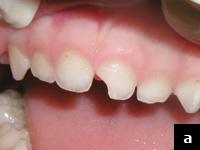 |
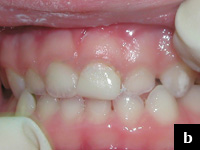 |
|---|
| Figures 8a and 8b. Fractured primary central incisor and composite restoration (TPH3 [Dentsply Caulk]). |
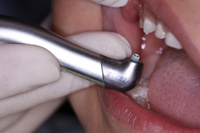 |
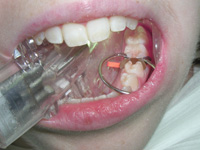 |
|
Figure 9. Using the Erbium; Chromium:YSGG laser (Waterlase MD). |
Figure 10. Mouthprop with light and evacuation (Isolite [Isolite Systems]). |
Other innovations include: simpler and easy to use composite polishing kits, such as the SS White Jazz Supreme Polishing Kit; Erbium; Chromium: YSGG Laser for hard tissue cavity preparation (Waterlase MD [Biolase Technology]) (Figure 9); alginate substitutes; segmental matrices (Figure 7b to 7c); nonstick matrices; mouthprop for isolation that incorporates both an intraoral light and saliva evacuation (Figure 10); disposable bleaching trays; digital operating microscopes (Figure 11); and plastic burs for the safe removal of dentinal caries (SS White Smartburs II). (Note: The products mentioned above can be viewed in the Read and Watch video by Dr. Margolis that accompanies this article located at the Web site dentistrytoday.com.)
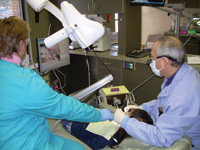 |
| Figure 11. Digital operating microscope (CamSight [CamSight]). |
CONCLUSION
Dentists who care for children and adolescents have the wonderful task and ability to create beautiful restorations for these young patients. With the advent of many wonderful techniques, devices, and materials, we can have “fun” while achieving professional satisfaction from creating beautiful restorations which help children and adolescents improve their self-image. I hope that each of you accept children into your practice so that you too can have the wonderful experiences that those of us who treat children on a daily basis enjoy.
Suggested Readings
Daou MH, Tavernier B, Meyer JM. Clinical evaluation of four different dental restorative materials: one-year results. Schweiz Monatsschr Zahnmed. 2008;118:290-295.
Drummond JL. Degradation, fatigue, and failure o
f resin dental composite materials. J Dent Res. 2008;87:710-719.Krämer N, Reinelt C, Richter G, et al. Nanohybrid vs. fine hybrid composite in Class II cavities: clinical results and margin analysis after four years. Dent Mater. 2009;25:750-759.
Krämer N, García-Godoy F, Frankenberger R. Evaluation of resin composite materials. Part II: in vivo investigations. Am J Dent. 2005;18:75-81.
Magne P. Composite resins and bonded porcelain: the postamalgam era? J Calif Dent Assoc. 2006;34:135-147.
Ritter R. Using a nanohybrid composite with ceramic-like properties. Dent Today. 2009;28:74.
Olivi G, Margolis F, Genevese MD. Pediatric Laser Dentistry: A User’s Guide and Atlas. Chicago, Ill: Quintessence Publishing; 2010.
Owens BM, Johnson WW. Effect of new generation surface sealants on the marginal permeability of Class V resin composite restorations. Oper Dent. 2006;31:481-488.
Dr. Margolis received his BS and DDS from The Ohio State University and his certificate in pediatric dentistry from the University of Illinois College of Dentistry. He is a clinical instructor at Loyola University’s Oral Health Center and an adjunct clinical assistant professor at the University of Illinois College of Dentistry. He has lectured internationally and has received Mastership from the Academy of Laser Dentistry. Dr. Margolis has contributed articles to both lay and professional journals. He is the author the book Beautiful Smiles for Special People, which is a course manual for dental personnel treating the disabled patient. He is co-author of a book Pediatric Laser Dentistry and Atlas, to be published by Quintessence in 2010. Dr. Margolis is in full-time private practice of pediatric dentistry in Buffalo Grove, Ill. He can be reached at kidzdr@comcast.net.
Disclosure: Dr. Margolis receives an honorarium and product from Biolase Technology, Inc and receives product from other manufacturers whose products may be used for illustration purposes.



